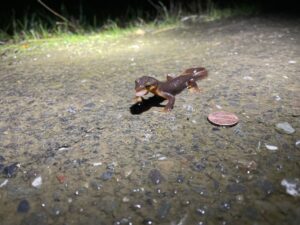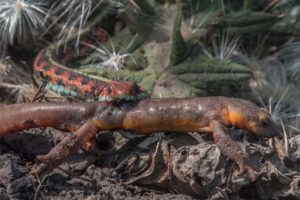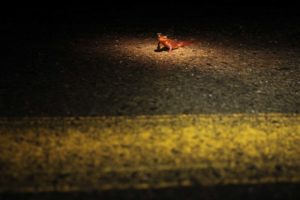This article was the first nature article published by Bay Nature cofounder David Loeb. It originally appeared in Terrain, the magazine once published by the Berkeley Ecology Center.
The small pond sits deep in an old quarry pit. Actually, it’s partly a pond and partly a tule marsh. It was at most three feet deep when I visited on the last day of January, at the end of a month-long series of rainstorms. The steep quarry walls—the exposed dikes of an ancient volcano—are a mixture of dark reddish-brown rock and lighter reddish-brown soil, scarred by gullies deepened the recent storms. A slide has deposited a mass of granular reddish dirt along the margin of the marsh’s western fringe.
The earth on the 150-foot high quarry wall above looks none too stable, though several coyote bushes hang on tenanciously about three quarters of the way up the wall. This might not be the best place for a picnic in the next big rainstorm.
It’s not raining now, though the sky is thoroughly overcast, and a thick fog rolls in periodically from Orinda to the east, on the other side of the hill. Usually you can see straight across to Mt. Diablo from the old road out of the quarry, but not today. Of course, that doesn’t matter down here in the quarry bottom, where the steep walls keep out any view of the outside world. The fog cover only heightens the sensation of being totally isolated, just a few miles east of downtown Oakland.
Although volcanic activity some 10 million years ago shaped this area now known as Sibley Volcanic Regional Preserve, this particular hole in the earth was not created by natural forces. For many decades up to the mid-1970’s, Kaiser Sand & Gravel Company gouged out the hillside to get at the extremely hard basalt left over from the Miocene Epoch volcano. This rock was reportedly an excellent material for use in road beds of the metastizing network of highways and byways progressively choking the Bay Area.
But sometimes clouds do have silver linings. Besides exposing a significant slice of Bay Area geologic prehistory, the scar left by Kaiser has now become a preferred breeding ground for hundreds of California newts, as well as Pacific tree frogs. And as I am visiting the quarry in the middle of Bay Area winter, the newts are out in force.
Of course, with newts, “in force” is not a particularly apt choice of words. Newts (genus Taricha, amphibian relatives of the salamander) don’t exactly overpower you; rather, they glide into your consciousness. In fact, as you walk down the hillside to the seemingly deserted quarter-acre pond, there’s not much sign of life at all. But stop by the bank for just a minute and adjust your eyes to look through the reflective surface of the dark water; in less than a minute, you are bound to see a brown or grey shape moving slowly through the water. Or a margin of a newt’s orange belly as it floats just below the surface of the pond. The bottom of the pond is covered with mud and vegetation; when a newt sits quietly below, it is hard to detect, as its muddy-brown back blends perfectly with its underwater environment.
You may first notice newt presence by watching for breaks in the water, as the newts grab quick gulps of air. Or you may first see the gentle, languid, elegant swish of the newt’s long tail, before noticing the body that precedes it. Newts sometimes swim with their legs tucked alongside their bodies, making them look more like eels. At other times, they also paddle with their short legs, particularly when changing direction or depth. Mostly, they just seem to float around. It generally takes a few minutes to see your first newt, but after a while (if you’re quiet), they’re visible all over the pond.
The back end of the quarry is starting to fill up with cattails and tule reeds—a step in the pond’s transition from a pond into a marsh, and eventually into a grassy field. Sitting quietly by the edge of the water here, where there’s a slender margin of water between the shore and the reeds, I have a ringside seat for the main event, the newt’s mating ritual. While I’d hesitate to call these slimy little brown amphibians “beautiful,” there is something magical about their mating dance.
At first glance, the mating pairs don’t look too different from their solo brethren floating and swimming nearby. However, some of the newts appear to be much fatter than the others. And then I realize that what I’m seeing isn’t one newt, but two, the two are moving so much in unison that they appear to be one organism. The guy is on top, holding on tenaciously to the female below, while she does most of the locomotive work, carrying him about here and there, though not with any seeming urgency.
There is a balletic quality to the movements of the pair, as they swim langorously about the pool. Of course, in a traditional ballet “pas de deux”, the male physically lifts and supports the female, and here we have the opposite. But it is the grace of the movements and the synchronicity of the two bodies that suggest the ballet, in spite of the gender role reversal.
The male holds on tight to his partner, legs wrapped around her chest and belly, hooked on just behind her front legs and just in front of the rear legs, in a maneuver called “amplexus.” In the fall, the male grows rough patches on the bottoms of his feet, enabling him to cling to the slippery skin of the female’s underbelly. Somehow, thus encumbered, she manages to paddle with her legs, as the two wave their tails in synchrony. Every so often they stop for a minute, still embracing, and then resume their graceful tour of the pond.
They don’t seem to be in any particular rush. I’ve watched a pair swimming together like this for at least ten minutes at a time before they move out of sight in the vegetation down below or further out into the pond. I have no idea how long they spend together like that. When they finally do part, they float off separately, with no apparent clue or signal. All in all, it could be worse, swimming and floating dreamily around a pool in the arms of your beloved, making leisurely love—all in the selfless pursuit of ensuring the abundance of future generations and preservation of the species.
Or so I thought. However, on consulting several texts by the Western US’s acknowledged expert on amphibians and reptiles, Robert C. Stebbins of UC Berkeley, I find that the female’s participation in this pas de deux may not be as dreamy or voluntary as it appears. Apparently, when the male mounts the female, he rubs her snout with his chin; a gland in the chin produces a secretion that “inhibits her struggles to escape.” I did not witness any apparent struggles or overtly coercive behavior; but, then again, I’m no expert in newt psychology.
The amplexus bonding does not include coitus, strictly defined—that’s just not the way newts “do it.” Rather, it’s more an extended foreplay. According to Stebbins, following amplexus, the male separates from the female. While she follows him closely (she’s more interested in the whole procedure by now, apparently), the male deposits a spermatophore (a mound of gelatinous substance with a sperm capsule on the top) from an enlarged vent between his legs. She picks up the capsule in her vent and stores it in a special internal cavity, to be released later as she lays her eggs.
The evidence of some initial success in the preservation of the species is visible around the edges of the marshy pond. Small, clear-white, bumpy, gelatinous sacks, a centimeter or two in diameter, are attached to numerous tule stalks just below the water line, or to other matter on the pond floor in the shallower areas. The eggs are in different stages of development, as some of the sacs have little white dots inside, while in others the white “dots” are now clearly elongated embryos, two or three millimeters long. (Some of them may be frog eggs, as the newts are currently sharing the pond with several Pacific tree frogs).
A decade ago, biologists were expressing concern about the health of newt populations in the East Bay hills. The staff at Tilden Park in the Berkeley hills were finding large numbers of tire-flattened newts along South Park Drive—up to 200 a day during rainstorms, when newts are most likely to be on the move. These findings led to the experimental closure of the road on rainy days in 1988, a move that was later extended to cover the whole November to March breeding season. According to a Park District naturalist, the inconvenience of the road closure has been largely accepted by the public as a worthwhile trade-off for the health of the local newt population. However, given the continuing fragmentation of newt habitat by roads and housing development throughout the East Bay hills, it is too early to declare victory for East Bay newts.
When I return to the quarry just nine days later, the scene has already changed. It has not rained in the interim, and the water in the pond is a good 6-8 inches lower. We find newts all right—my son counted 13 in the course of half an hour—but we really had to look for them; we can’t just stand back and see a several dozen newts swimming about at one time. The newts we do see were moving very slowly or not at all, mostly along the pond bottom, disappearing under the vegetative cover. The level of activity in general has diminished considerably, and there are no visible mating pairs. Are they all done for the year, or just waiting for more rain? It is true that while the males spend most of the winter in the water (growing fins on their tails every fall for better propulsion in swimming), the females only come in to the water to mate (and don’t grow fins). Once they’ve laid their eggs, they’re out of there, back to the decomposing logs and underground burrows where they spend most of their lives. Perhaps for now, then, the newts’ winter mating dance is over. But all of those egg sacks very much in evidence all along the edges of the pond are the promise I take away with me of more small amphibian miracles in years to come.





